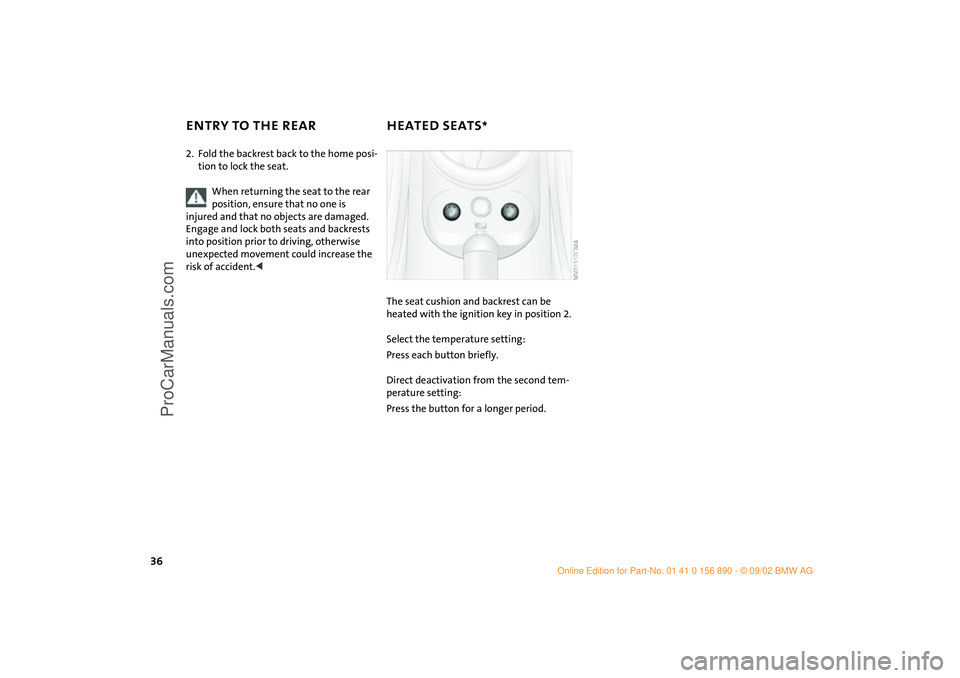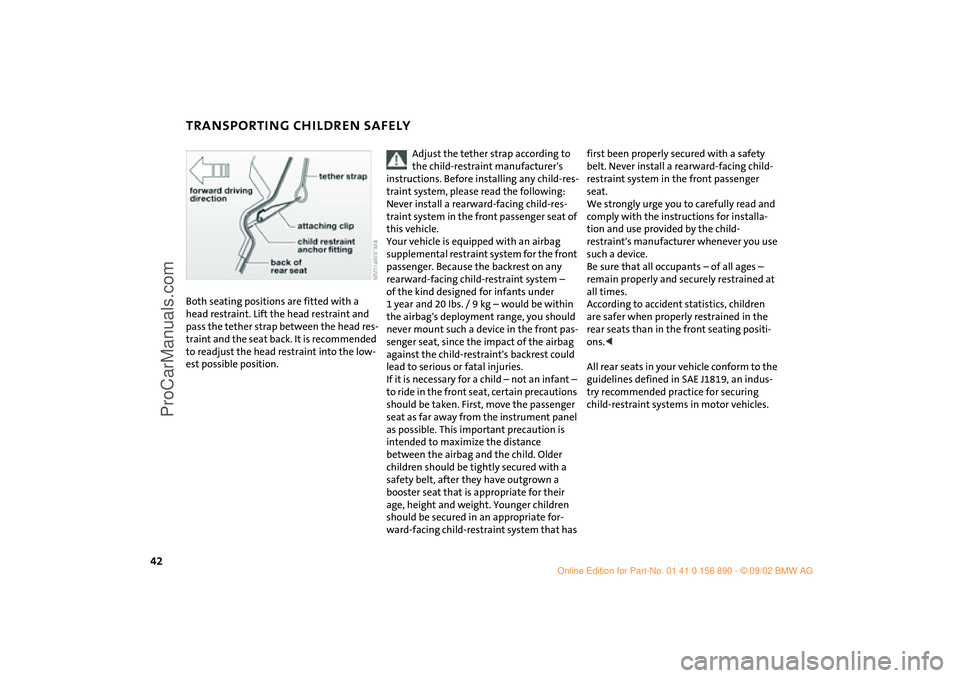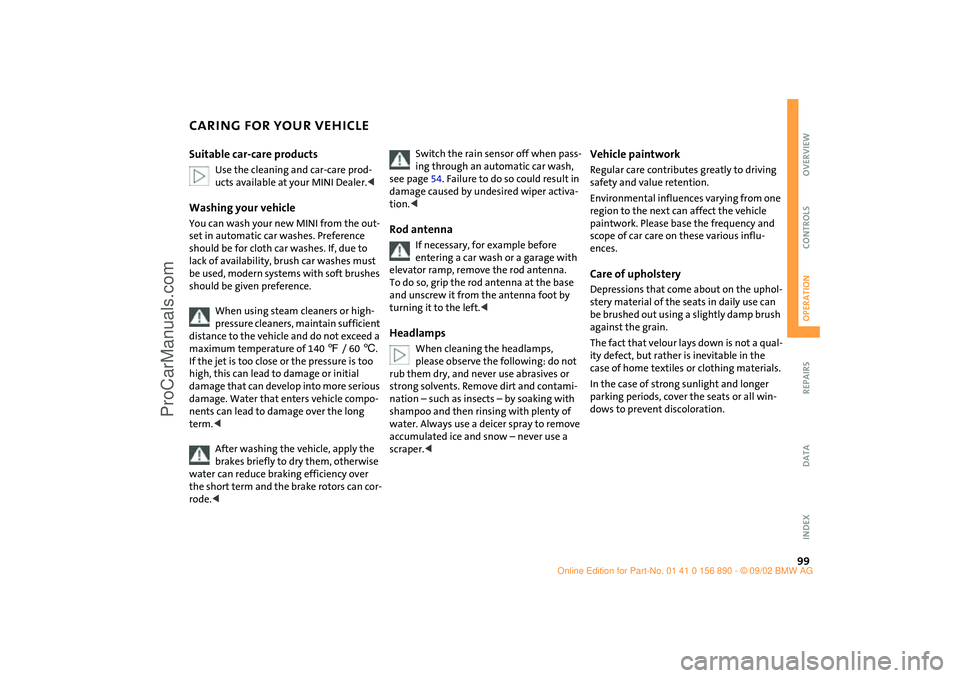seats MINI COOPER 2003 Owners Manual
[x] Cancel search | Manufacturer: MINI, Model Year: 2003, Model line: COOPER, Model: MINI COOPER 2003Pages: 148, PDF Size: 3.17 MB
Page 4 of 148

CONTENTS
2
© 2002 Bayerische Motoren Werke
Aktiengesellschaft
Munich, Germany
Reprinting, including excerpts, only with the
written consent of BMW AG, Munich.
Order No. 01 41 0 156 890
US English VIII/02
Printed in Germany
Printed on environmentally friendly paper –
bleached without chlorine, suitable for recycling.
Notes
About this Owner's Manual6
Symbols used6
Your individual vehicle6
Editorial notice7
For your own safety7
Symbol on vehicle parts8
Service and warranty8
Reporting safety defects8
At a glance
Cockpit12
Display elements13
Display elements with navigation
system14
Indicator and warning lamps15
Multifunction steering wheel19
Controls and features
Opening and closing:
Keys22
Central locking system23
Opening and closing – from outside23
Opening and closing – from inside26
Tailgate27
Electric power windows28
Sliding/tilt sunroof29
Roller sun blind30
Alarm system31
Adjustments:
Safe seating position33
Seat adjustment34
Entry to the rear35
Heated seats36
Head restraints37
Safety belts38
Steering wheel38
Mirrors39
Airbags40
Transporting children safely41
Vehicle Memory44
ba.book Seite 2 Montag, 5. August 2002 8:09 20
ProCarManuals.com
Page 36 of 148

34
SEAT ADJUSTMENTImportant adjustment information
Never try to adjust your seat while
operating the vehicle. The seat could
respond with an unexpected movement,
and the ensuing loss of vehicle control
could lead to an accident.
Never ride with the backrest reclined to an
extreme horizontal angle – especially
important for front passengers to remem-
ber. Keep the backrest relatively upright to
minimize the risk of sliding under the
safety belt and sustaining injury in an acci-
dent.<
To adjust the seats, see the following sec-
tion.
Longitudinal seat adjustment 1. Lift the handle
2. Push the seat into the desired position
3. After releasing the handle, apply pres-
sure to the seat to ensure that the latch
engages securely.
Make corrections in the longitudinal
adjustment of the seat to ensure that
the safety belt still fits firmly against your
body. If you do not do this, the protection
provided by the safety belt may be
reduced.<
Seat height 1. To raise:
Pull the handle up repeatedly, continu-
ing until the seat reaches the desired
height
2. To lower:
Push the handle repeatedly, continuing
until the seat reaches the desired height.
ba.book Seite 34 Montag, 5. August 2002 8:09 20
ProCarManuals.com
Page 38 of 148

36
ENTRY TO THE REAR HEATED SEATS
*
2. Fold the backrest back to the home posi-
tion to lock the seat.
When returning the seat to the rear
position, ensure that no one is
injured and that no objects are damaged.
Engage and lock both seats and backrests
into position prior to driving, otherwise
unexpected movement could increase the
risk of accident.<
The seat cushion and backrest can be
heated with the ignition key in position 2.
Select the temperature setting:
Press each button briefly.
Direct deactivation from the second tem-
perature setting:
Press the button for a longer period.
ba.book Seite 36 Montag, 5. August 2002 8:09 20
ProCarManuals.com
Page 39 of 148

37
OVERVIEW REPAIRS OPERATIONCONTROLS DATA INDEX
HEAD RESTRAINTSAdjusting the head restraintsTo raise: pull the head restraint upward.
To lower: press the button and push the
head restraint downward.
You can reduce the risk of spinal
injury and whiplash by adjusting the
head restraint to a height at which it is cen-
tered roughly at ear level.<
Removal1. Pull up the head restraint, continuing
until it is at maximum extension
2. Press the button and remove the head
restraint at the same time.Installation1. Press the button and at the same time
insert the head restraint in the reception
points
2. Adjust the head restraint.
To avoid possible violation of traffic
laws, never retract the head res-
traints unless the rear seats are empty.
Always ensure that the head restraints are
raised before transporting passengers in
the rear seat.<
ba.book Seite 37 Montag, 5. August 2002 8:09 20
ProCarManuals.com
Page 40 of 148

38
SAFETY BELTS STEERING WHEEL Drive with your safety belt onEven though there is an airbag, always fasten
your seat belt before driving off, because air-
bags are designed to enhance the effective-
ness of the safety belts, not to replace them.To fastenMake sure you hear the lock engage in the
belt buckle.
The warning lamp – Fasten safety
belts – lights up for several seconds
or until after the safety belts are
fastened.To release1. Press the red button in the belt buckle
2. Hold the belt
3. Guide the belt back into its reel.
Safety belt height adjustmentUse the height adjustment mechanism to
adapt the safety belt to the ideal position
for your own body:
Press the button and at the same time push
the entire unit upwards or downwards.
Also observe the instructions on adjusting
the seats on page 33.
If the safety belts are damaged or
stretched in an accident: have the
safety belt system replaced by your MINI
Dealer and the belt anchors checked, other-
wise the safety function can no longer be
guaranteed. If a child-restraint system was
in the vehicle during an accident, consult
the manufacturer's instructions regarding
replacement.<
To adjust the steering wheel height1. Push the locking lever downward
2. Adjust the desired steering wheel posi-
tion
3. Pull the lever back in.
Do not adjust the steering wheel
while the vehicle is moving, other-
wise unexpected movement could increase
the risk of accident.<
ba.book Seite 38 Montag, 5. August 2002 8:09 20
ProCarManuals.com
Page 42 of 148

40
AIRBAGS 1Side airbags in seatback on the driver
and passenger side – front
2Head airbags on the driver and passen-
ger sides for both rows of seats –
front/rear
3Front airbags on the driver and passen-
ger sidesProtective effectThe front airbags supplement the safety
belts by providing additional protection for
the driver and front passenger in the event
of a frontal collision in which the protec-
tion afforded by the belts alone may no
longer be sufficient.
When needed, the head and side airbags
help to furnish protection in the event of
side impact.
Each of the side airbags is designed to help
support the seat occupant's upper body.
For information on sitting posture, refer to
page 33.
The airbags do not deploy in response
to minor collisions, rear impacts and
certain kinds of vehicle rollover.<
Even when all safety guidelines are
observed, there is a small residual risk that
passengers will sustain facial, hand or arm
injuries in isolated instances. The ignition
and inflation noise may induce a mild tem-
porary hearing loss in sensitive individuals.
Do not apply adhesive materials to
the cover panels of the airbags, cover
them or modify them in any other way. Do
not fit covers, cushions or other items to
the front seats that have not been specially
approved for seats with side airbags. Do
not hang clothing, e. g. jackets, over the
backrests. Do not attempt to remove the
airbag restraint system from the vehicle. In
the event of malfunctions, immobilization
or use, i. e. triggering, of the airbag restraint
system in accordance with its intended
function, commission a MINI Dealer with
the inspection, repair or disassembly. Do
not make any changes yourself to the indi-
vidual components and wiring. This
includes the padded covers of the steering
wheel, instrument panel and the roof sup-
ports, as well as the sides of the roofliner
and the original backrest covers on the
front seats. Do not attempt to remove or
dismantle the steering wheel. In view of
the applicable safety regulations, arrange
for your MINI Dealer to dispose of the air-
bag generators. Unprofessional attempts
to service the system could lead to failure
in an emergency or undesired airbag acti-
vation, either of which could result in per-
sonal injury. Do not touch the individual
components directly after the system has
been triggered, as otherwise there is a dan-
ger of burns.<
At all times, occupants should sit
upright and be properly restrained,
infants and small children in appropriate
child-restraint systems, larger children and
adults using the safety belts. Never let an
occupant's head rest near or on a head air-
bag because the inflating airbag could
cause serious or fatal injury. A child which
is not properly restrained could place his or
her head on or near the airbag.<
ba.book Seite 40 Montag, 5. August 2002 8:09 20
ProCarManuals.com
Page 43 of 148

41
OVERVIEW REPAIRS OPERATIONCONTROLS DATA INDEX
AIRBAGS TRANSPORTING CHILDREN SAFELYIndicator lamp
The indicator lamp on the instru-
ment panel shows the airbag sys-
tem status starting from ignition
key position 1.
System operational:
>The indicator lamp comes on briefly.
System malfunction:
>The indicator lamp does not come on
>The indicator lamp fails to go out after
the engine has been started, or it comes
on during normal driving.
A system defect could prevent the airbags
from deploying in response to a severe
impact occurring within the system's nor-
mal triggering range.
Have the airbag system checked as soon as
possible by your MINI Dealer.
Children younger than 12 years of age or
smaller than 5 ft / 150 cm must be trans-
ported in suitable child-restraint system.
Otherwise there is an increased risk of
injury in the event of an accident.
Commercially-available child-restraint sys-
tems are designed to be secured with a lap
belt or with the lap belt portion of a combi-
nation lap/shoulder belt. Improperly or
inadequately installed restraint systems
can increase the risk of injury to children.
Always read and follow the instructions
that come with the system.
If you use a child-restraint system with a
tether strap:
Your vehicle has one of two different types
of child-restraint anchor fittings on the
back of the rear seats, see arrows 1 or 2.
Depending on the location selected for
seating in the rear passenger area, attach
the tether strap to the corresponding
anchorage point to secure the child-
restraint system.
Adjust the tether strap according to the
child-restraint manufacturer's instructions.
Anchor fitting 1 is shown above.
Anchor fitting 2 is shown in the next
column.<
ba.book Seite 41 Montag, 5. August 2002 8:09 20
ProCarManuals.com
Page 44 of 148

42
TRANSPORTING CHILDREN SAFELYBoth seating positions are fitted with a
head restraint. Lift the head restraint and
pass the tether strap between the head res-
traint and the seat back. It is recommended
to readjust the head restraint into the low-
est possible position.
Adjust the tether strap according to
the child-restraint manufacturer's
instructions. Before installing any child-res-
traint system, please read the following:
Never install a rearward-facing child-res-
traint system in the front passenger seat of
this vehicle.
Your vehicle is equipped with an airbag
supplemental restraint system for the front
passenger. Because the backrest on any
rearward-facing child-restraint system –
of the kind designed for infants under
1 year and 20 Ibs. / 9 kg – would be within
the airbag's deployment range, you should
never mount such a device in the front pas-
senger seat, since the impact of the airbag
against the child-restraint's backrest could
lead to serious or fatal injuries.
If it is necessary for a child – not an infant –
to ride in the front seat, certain precautions
should be taken. First, move the passenger
seat as far away from the instrument panel
as possible. This important precaution is
intended to maximize the distance
between the airbag and the child. Older
children should be tightly secured with a
safety belt, after they have outgrown a
booster seat that is appropriate for their
age, height and weight. Younger children
should be secured in an appropriate for-
ward-facing child-restraint system that has
first been properly secured with a safety
belt. Never install a rearward-facing child-
restraint system in the front passenger
seat.
We strongly urge you to carefully read and
comply with the instructions for installa-
tion and use provided by the child-
restraint's manufacturer whenever you use
such a device.
Be sure that all occupants – of all ages –
remain properly and securely restrained at
all times.
According to accident statistics, children
are safer when properly restrained in the
rear seats than in the front seating positi-
ons.<
All rear seats in your vehicle conform to the
guidelines defined in SAE J1819, an indus-
try recommended practice for securing
child-restraint systems in motor vehicles.
ba.book Seite 42 Montag, 5. August 2002 8:09 20
ProCarManuals.com
Page 101 of 148

99
OVERVIEW REPAIRSOPERATIONCONTROLS DATA INDEX
CARING FOR YOUR VEHICLESuitable car-care products
Use the cleaning and car-care prod-
ucts available at your MINI Dealer.<
Washing your vehicle You can wash your new MINI from the out-
set in automatic car washes. Preference
should be for cloth car washes. If, due to
lack of availability, brush car washes must
be used, modern systems with soft brushes
should be given preference.
When using steam cleaners or high-
pressure cleaners, maintain sufficient
distance to the vehicle and do not exceed a
maximum temperature of 140 7 / 60 6.
If the jet is too close or the pressure is too
high, this can lead to damage or initial
damage that can develop into more serious
damage. Water that enters vehicle compo-
nents can lead to damage over the long
term.<
After washing the vehicle, apply the
brakes briefly to dry them, otherwise
water can reduce braking efficiency over
the short term and the brake rotors can cor-
rode.<
Switch the rain sensor off when pass-
ing through an automatic car wash,
see page 54. Failure to do so could result in
damage caused by undesired wiper activa-
tion.<
Rod antenna
If necessary, for example before
entering a car wash or a garage with
elevator ramp, remove the rod antenna.
To do so, grip the rod antenna at the base
and unscrew it from the antenna foot by
turning it to the left.<
Headlamps
When cleaning the headlamps,
please observe the following: do not
rub them dry, and never use abrasives or
strong solvents. Remove dirt and contami-
nation – such as insects – by soaking with
shampoo and then rinsing with plenty of
water. Always use a deicer spray to remove
accumulated ice and snow – never use a
scraper.<
Vehicle paintwork Regular care contributes greatly to driving
safety and value retention.
Environmental influences varying from one
region to the next can affect the vehicle
paintwork. Please base the frequency and
scope of car care on these various influ-
ences.Care of upholstery Depressions that come about on the uphol-
stery material of the seats in daily use can
be brushed out using a slightly damp brush
against the grain.
The fact that velour lays down is not a qual-
ity defect, but rather is inevitable in the
case of home textiles or clothing materials.
In the case of strong sunlight and longer
parking periods, cover the seats or all win-
dows to prevent discoloration.
ba.book Seite 99 Montag, 5. August 2002 8:09 20
ProCarManuals.com
Page 102 of 148

100
CARING FOR YOUR VEHICLECare of special parts >Light-alloy wheels
*:
Use wheel cleaner especially during the
winter months, but do not use any
aggressive, acidic, strong alkali or rough
cleansers or steam jets above 140 7 /
60 6. Observe the manufacturer's
instructions
>Chrome parts
* such as cooler grille, door
handles, etc.:
Especially if exposed to road salt, care-
fully clean these parts with plenty of
water and possibly with a shampoo addi-
tive.
For additional treatment, use chrome
polish
>Rubber parts:
Treat only with water or rubber care
products
Do not use silicon sprays or other
silicon-containing care products,
otherwise noise and damage could
occur.<
>Plastic parts, imitation leather surfaces,
headliner, lamp glass, covering glass for
the instrument cluster, as well as matt
black molded parts:
Clean with water and, if necessary, plas-
tic care products. Do not dampen seats
and the headliner.
Never use solvents such as lacquer thin-
ner, heavy-duty grease remover, fuel or
similar
>Wood paneling
*:
Please clean wood paneling and other
wood parts only with a damp cloth. Dry
off with a soft cloth
>Safety belts:
Only clean using mild soap, leaving the
belts fitted.
Do not dry clean, as the fabric can be
destroyed.
Always roll up safety belts only when dry.
Dirty safety belts prevent unrolling and
thus negatively affect safety>Floor carpets and floor mats
*:
If heavily soiled, clean using interior
cleaner. Floor mats can be removed to
allow the interior to be cleaned
>Wiper blades:
Clean with soapy water. Replace wiper
blades twice a year, before and after the
cold season. This is particularly impor-
tant on vehicles fitted with a rain sensor.
ba.book Seite 100 Montag, 5. August 2002 8:09 20
ProCarManuals.com